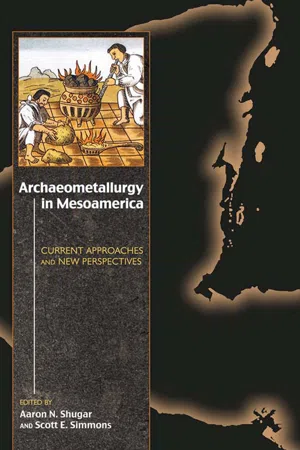![]()
SEVEN
Breaking the Mold
THE SOCIOECONOMIC SIGNIFICANCE OF METAL ARTIFACTS AT MAYAPÁN
Elizabeth H. Paris and Carlos Peraza Lope
The Postclassic Period was a dynamic era for the Maya residents of the Yucatán Peninsula. The increase in volume and diversity of trade goods in circulation (Sabloff and Rathje 1975; Smith and Berdan 2003), the creation and combination of cross-cultural iconography and symbol sets, the circulation of new forms of currency and standards of value, and the expansion of coastal trade routes brought new opportunities for the creation of wealth, status, political power, and intercultural communication. New consumer goods and production techniques—along with the knowledge, values, and meanings that accompanied them—were adopted and adapted by the Maya in ways that gave them local values and meanings. For the residents of the Postclassic political center of Mayapán, metal artifacts became visible indicators of elite social and political power as sacred objects incorporated into major religious ceremonies and as storable and portable wealth (Pollard 1987, 741). However, because metallurgy was a nonindigenous technology that arrived late in the Maya region, metal objects and metal production technologies were incorporated into the existing cultural fabric in ways that reflected the uses and meanings of other “precious objects” in Maya culture, particularly objects such as jade and shell ornaments. Like jade and shell ornaments, the metal objects created and consumed at Mayapán were used for display.
In daily life, tools such as needles made from valuable metals were simultaneously utilitarian and exotic markers of status;1 metal ornaments could be attached to clothing or worn as jewelry. They could also be used for special functions and occasions—displayed through special rituals or interred in burials or caches—and they could denote offerings. In this chapter we argue that the exotic nature of metal in the Maya region made metal objects visible indicators of wealth and desirable interregional commodities, while the plastic properties of metal enabled local producers to create and re-create objects particularly suited to the needs of Mayapán consumers and production capacities.
COMMODITIES AND VALUE
Commodities such as metal objects were economically, socially, and ritually valuable in Maya culture. The Maya were not unique in this, nor was this multifaceted valuation limited to metal. Commodities, defined as “anything intended for exchange” (Appadurai 1986, 9), often have multiple meanings and are assigned value (Renfrew 1975, 22) according to the economic, social and ritual roles they fulfill in particular contexts. These multiple meanings may be expressed simultaneously or may change according to context. Commodities may be perishable or nonperishable; however, nonperishable craft items generally have higher archaeological visibility. They may include food and necessities, raw materials, domestic or industrial tools and materials, clothing, jewelry or display items, luxury items, money, and ritual paraphernalia, and may have widely variable spheres of distribution, from local to interregional in scope.
Within cultures or regions, commodities made from particular materials tend to be assigned a relatively high value due to the physical or visual properties of these materials, especially in regions where these materials are considered rare and exotic. For example, items made from gold, silver, copper, and lead metals (Roberts 2009), as well as ivory and precious stones, became highly valuable in economic, social, and ritual contexts in the Western world (Abu-Lughod 1989) before and after the introduction of formal currency. By transforming metal from its raw state into finely crafted items, producers could greatly increase the economic, social, and ritual value of metal items. Such items were highly regarded throughout the ancient world, including in ancient Mesoamerica.
Cross-culturally, craft items used as commodities often reflect multiple aspects of social identity, such as wealth, social status, religion and ideology, political position, occupation, age, gender, and ethnicity (Costin 1998, 3). Craft objects can also be used to complete economic transactions or create and solidify social and political relationships (Dalton 1982, 184). Modern Western examples of such items include engagement and wedding bands, jewelry displaying religious symbols, paintings or decorative architectural elements, clothing worn at religious services or ceremonies, religious paraphernalia, and elaborated visual religious symbols at a variety of scales. Such items may express economic wealth through size, style, craftsmanship, and the origin, cost, or rarity of the raw materials. They may express social status ...
